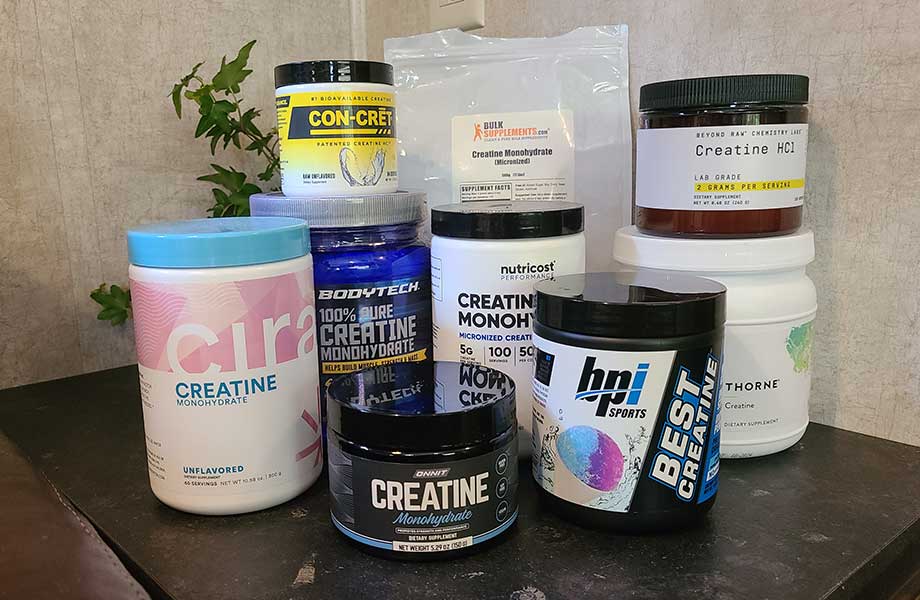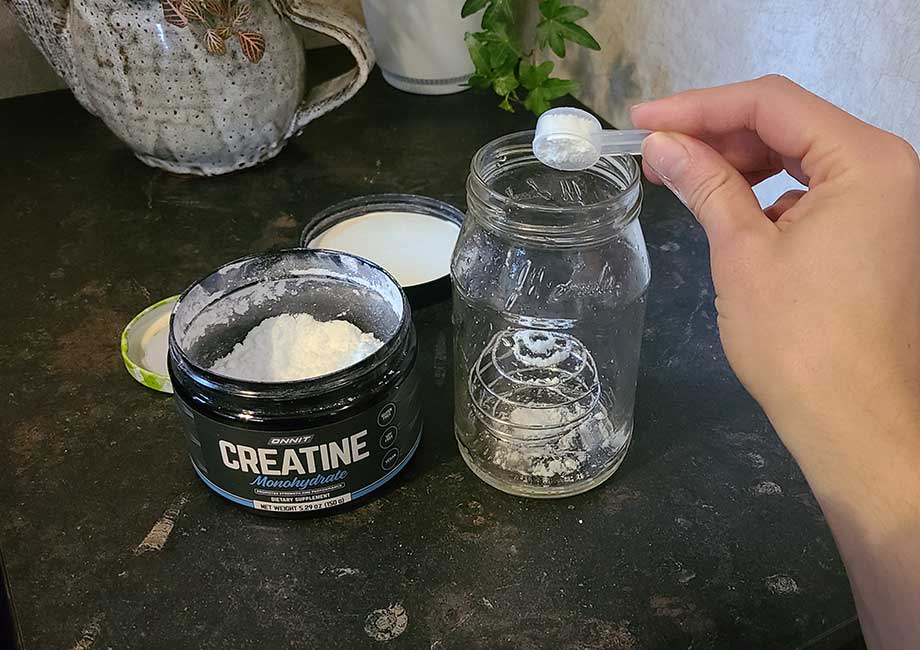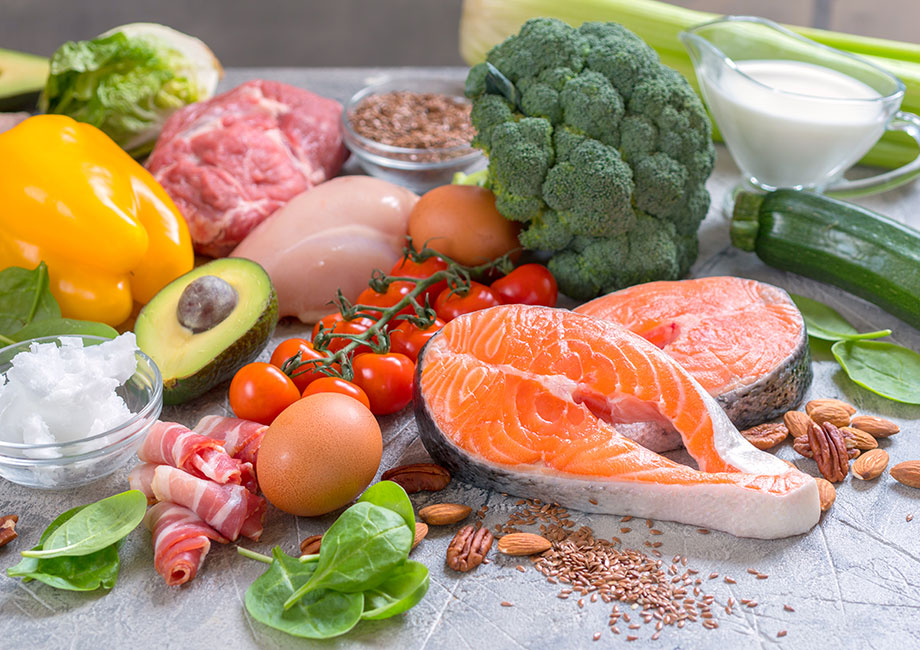We test and review fitness products based on an independent, multi-point methodology. If you use our links to purchase something, we may earn a commission. Read our disclosures.
Bodybuilders and fitness enthusiasts are well aware of the benefits of creatine when it comes to boosting muscle mass and supporting optimal exercise performance. While creatine monohydrate supplements are both highly researched and wildly popular with the public, many overlook the foods with creatine that they could be including in their diet.
RELATED: Best Creatine
When we think of creatine monohydrate, we think of that scoop of white powder, so it’s easy to forget that it’s actually a natural compound. That said, pretty high amounts of it can be found in foods you are very likely eating on a regular basis already. So, whether you want to supplement with sports nutrition’s favorite supplement naturally or you just want to optimize your creatine intake, let’s take a look at the best foods that serve as natural sources of creatine.
Medical disclaimer: This article is intended for educational and informational purposes only. It is not intended as a substitute for medical advice. For health advice, contact a licensed healthcare provider.
What Is Creatine?
Creatine is a compound that is synthesized naturally from the amino acids arginine, glycine, and methionine. Creatine supplements are the most common way that people get their creatine. However, creatine is also present in foods that are high in certain amino acids, namely animal-based foods like red meat, chicken breast, and dairy products.

RELATED: What Is Creatine?
So, why do people seek out creatine in the first place? Most of the creatine stored in the muscles is made up of phosphocreatine. Cells produce an energy source called ATP, also known as adenosine triphosphate, in their mitochondria. The more ATP you have, the longer you can perform exercise.
Thus, people who regularly engage in high-intensity exercise, especially those who could benefit from an enhancement in athletic performance on a competitive level, swear by creatine benefits. We normally get all the ATP we need from food, so we can do everything from play video games to play with our pets.
When our ATP runs out, our muscles cannot contract as powerfully, resulting in failure and fatigue during resistance training. So, maintaining high concentrations of creatine in the muscle cells can make a big difference in your exercise performance1.
The effects of creatine supplementation don’t just stop at ATP production, though. Creatine supplements can also help with muscle growth, boost athletic performance, and even aid with weight loss from fat.
As we said, though, you can get creatine without supplements, albeit in much smaller concentrations. So, what are these food sources of creatine? Is there a source of creatine that’s superior to others? Let’s take a look.
Best Foods with Creatine
The best natural sources of creatine come from animal products and this is simply because animal-based foods tend to have more of the amino acids needed for creatine synthesis. However, plant sources can also contribute to creatine intake. We’ll be talking about both as a source of creatine as well as the amounts in specific foods so you have a good idea of how to maximize the creatine content of your diet.
RELATED: How To Take Creatine
Seafood
The incredible thing about seafood is, not only does it tend to have a higher creatine content than other animal products, but some of these foods also contain omega-3 fatty acids. Most people are familiar with the heart and brain health benefits of omega-3 fatty acids. However, recent science has shown that omega-3s also have athletic performance benefits2 in helping with muscle recovery, muscle strength, and even concussion prevention due to their role in brain function.
- Herring (4 oz) – 938 mg
- Salmon (4 oz) – 511 mg
- Tuna (4 oz) – 455 mg
- Cod (4 oz) – 341 mg
- Shrimp (3 oz) – 20 mg

Red Meat
Among animal-based foods, red meat has some of the highest creatine levels next to seafood. We will also be including some game meat here, for those who enjoy those sources of protein. The saturated fat in game meat is lower, as well, which is something to be aware of.
Though red meat is a good source of creatine, choosing the wrong cuts or packages could cause you to consume too many unhealthy fats that not only increase your risk of heart disease, but cause inflammation that can negatively impact athletic performance. Choose lean cuts of meat and choose ground meat options that are 92/8 or lower.
- Pork (4 oz) – 568 mg
- Beef/Steak (4 oz) – 511 mg
- Venison (4 oz) – 505 mg
- Bison (4 oz) – 456 mg
- Beef Broth (½ cup) – 379 mg
Poultry
Don’t eat red meat? No problem, poultry is also an excellent source of both protein and creatine. We included values for chicken here as, for whatever reason, the exact creatine content of turkey is not exactly known. What we do know, however, is turkey has slightly lower creatine levels than chicken. Chicken broth is also a smart source for those on a calorie-controlled diet.
Chicken (4 oz) – 443 mg
Chicken broth (½ cup) – 196 mg
Eggs (2 eggs) – 10 mg

Dairy
Now, when compared to natural foods like meats, dairy has significantly lower grams of creatine per serving. However, dairy products are an important natural source of creatine for vegetarians who eat animal products, but don’t eat meat.
Now, some of you may be wondering, what about whey protein? Surely it must be packed with creatine as well, given its high protein content and amino acid profile. This answer is murky, as different brands use different processing methods for isolating the whey. Some of these processes remove the creatine completely, some do not. Given this fact, we did not include whey on the list below.
Dairy is also good for those who are active as it can be a great source of vitamin D. Recent studies have shown that vitamin D can help one be more efficient at building muscle mass and modulate the inflammatory response that can reduce muscle size3.
Finally, though cheese is a better source of creatine compared to milk, cheeses can carry a high calorie count and unhealthy fats that minimize the health benefits. So, use cheese as your source of creatine sparingly.
- Milk (4 oz) – 13 mg
- Parmesan cheese (1 oz) – 103 mg
- Romano Cheese (1 oz) – 92 mg
- Gruyere Cheese (1 oz) – 83 mg
- Swiss Cheese (1 oz) – 79 mg
- Gouda Cheese (1 oz) – 77 mg
- Provolone Cheese (1 oz) – 76 mg
Here’s our examples again in order from highest to lowest:
| Source | Amount of Creatine (milligrams) |
| Herring (4 oz) | 938 mg |
| Pork (4 oz) | 568 mg |
| Salmon (4 oz) | 511 mg |
| Beef/Steak (4 oz) | 511 mg |
| Venison (4 oz) | 505 mg |
| Bison (4 oz) | 456 mg |
| Tuna (4 oz) | 455 mg |
| Chicken (4 oz) | 443 mg |
| Beef broth (½ cup) | 379 mg |
| Cod (4 oz) | 341 mg |
| Chicken broth (½ cup) | 196 mg |
| Parmesan cheese (1 oz) | 103 mg |
| Romano cheese (1 oz) | 92 mg |
| Gruyere cheese (1 oz) | 83 mg |
| Swiss cheese (1 oz) | 79 mg |
| Gouda cheese (1 oz) | 77 mg |
| Provolone cheese ( 1 oz) | 76 mg |
| Shrimp (3 oz) | 20 mg |
| Milk (4 oz) | 13 mg |
| Eggs (2 eggs) | 10 mg |
Vegan Sources of Creatine
Unfortunately, vegans are not able to consume natural foods that contain creatine, as these foods are not permitted by their diet. However, vegans can still have foods that naturally contain arginine, glycine, and methionine, which are the amino acids needed for the body’s natural creatine synthesis.
If you adhere to a vegan diet and don’t like the sound of this compromise, a registered dietitian nutritionist would likely advise you to take creatine supplements. Nearly all creatine monohydrate supplements are vegan friendly and, across the board, it’s just the most efficient way to get the full benefits of creatine.

RELATED: Best Vegan Creatine
That said, below are some best foods that are vegan-friendly and good sources of those aforementioned amino acids, they also contain trace amounts of creatine.
- Pumpkin seeds
- Sesame seeds
- Lentils
- Legumes (white beans, chickpeas, black beans, etc.)
- Quinoa
- Brown rice
- Barley
- Walnuts
- Almonds
- Watercress
- Broccoli
- Spinach
Benefits of Creatine
Muscular Endurance
Despite its role in boosting energy production in the skeletal muscle, creatine actually boosts muscular endurance as well as muscle strength and power. Researchers found that taking creatine monohydrate helped healthy adults bench press 26% more reps compared to taking a placebo, which only allowed them to perform 12% more reps4.
More Optimal Recovery
Since creatine can generate more energy for muscle cells, it can play a major role in reducing muscle soreness and improving recovery 1. By doing so, it helps you to maintain muscle strength during multiple bouts of exercise without excessive soreness holding you back from going all out. Furthermore, creatine supplementation can reduce muscle damage by reducing the inflammatory response caused by exercise.
Muscle Growth
People who engage in regular weightlifting can gain more muscle mass by consuming adequate creatine. Creatine is even more effective when supplemented with a diet high in carbohydrates5 and animal products.
Carbohydrates increase the production of insulin, which is hypothesized to improve the uptake of creatine for higher creatine levels than just consuming creatine alone. So, if you choose to start eating some of the foods above, consider eating healthy carbohydrates along with them like legumes or quinoa.
RELATED: Creatine vs Protein
How Much Creatine Do I Need?
The short answer is 5 grams of creatine. The optimal, efficacious dose of creatine monohydrate is 5 grams6 with efficacious meaning this is the amount of creatine needed to increase creatine stores and experience benefits.

Now, if you’ve been paying attention, your eyebrows are probably way up there right now. Yep, that’s because you would need to eat an awful lot of food sources listed above to get to 5 grams. When you also consider how protein rich foods are very satiating, meaning they produce a feeling of being full, it can make getting enough creatine naturally physically difficult.
This is why most people get most of their grams of creatine from creatine monohydrate supplements. Fitness people have enough to track with macros, calories, weight, reps, sets, body composition, and performance numbers…do we really want to count out how many grams of creatine we’re getting from food, too?
I mean, you certainly can, but supplementation is an irrefutably more efficient way to hit 5 grams. This is especially true for vegans and vegetarians, for which creatine-rich foods are just out of the question for their diet.
Keep in mind that creatine supplements do have side effects, but they are mostly harmless. Some people report mild GI distress as their stomach gets used to the compound, but the most common side effects are bloating and water retention. These creatine side effects are temporary, however, and will usually subside with consistent supplementation.
Foods with Creatine: Final Thoughts
While there are certainly creatine-rich foods in the form of animal products, by far the most efficient way to increase your muscle creatine is with creatine supplements. Athletes and bodybuilders may have the capacity to eat enough natural foods that contain creatine, but even then, a creatine supplement to be safe is still a good idea.
Keep in mind that the levels of creatine are highest in animal products that are uncooked. For example, beef and chicken have their creatine content reduced by 5% when cooked. When slow cooking your meat, as much as 30% of the amount of creatine can be reduced—after braising beef for a barbecue after an hour, for example.
This is all well and good if you’re a fan of sushi or rare steak, but for other uncooked meats, it can be downright dangerous. This is another reason supplementation is just overall better. Given that many of the benefits you get from creatine can only be amplified by the same protein-rich foods that contain creatine naturally, it may be best to just stick to lean versions of these foods and supplement on top of them.
Foods with Creatine: FAQs
How can I get creatine naturally?
Natural sources of creatine are in animal-based foods, with the highest grams of creatine being in seafood.
Do eggs have creatine?
Eggs do contain creatine, but only in small quantities and only in the yolk. Two eggs provides only about 10 milligrams of creatine.
How much creatine should I eat?
To get the full benefits of creatine, you need to get at least 5 grams. It is possible to get all of this naturally by working with a dietitian nutritionist to tailor your diet. However, supplementing is likely more efficient than eating your creatine in whole foods.
How is creatine used in the body?
Creatine is used in the body to boost ATP production and nourish muscle cells, which can, in turn, help improve performance during weightlifting and support muscle gain.
Is creatine bad for you?
No, creatine is not bad for you! It’s present in food naturally and healthy adults tolerate creatine supplements just fine when taken as directed.
These statements have not been evaluated by the Food and Drug Administration. This product is not intended to diagnose, treat, cure, or prevent any diseases.
References
- Wu SH, Chen KL, Hsu C, et al. Creatine Supplementation for Muscle Growth: A Scoping Review of Randomized Clinical Trials from 2012 to 2021. Nutrients. 2022;14(6):1255. Published 2022 Mar 16. doi:10.3390/nu14061255
- Thielecke F, Blannin A. Omega-3 Fatty Acids for Sport Performance-Are They Equally Beneficial for Athletes and Amateurs? A Narrative Review. Nutrients. 2020;12(12):3712. Published 2020 Nov 30. doi:10.3390/nu12123712
- de la Puente Yagüe M, Collado Yurrita L, Ciudad Cabañas MJ, Cuadrado Cenzual MA. Role of Vitamin D in Athletes and Their Performance: Current Concepts and New Trends. Nutrients. 2020;12(2):579. Published 2020 Feb 23. doi:10.3390/nu12020579
- Rawson ES, Volek JS. Effects of creatine supplementation and resistance training on muscle strength and weightlifting performance. J Strength Cond Res. 2003;17(4):822-831. doi:10.1519/1533-4287(2003)017<0822:eocsar>2.0.co;2
- Wax B, Kerksick CM, Jagim AR, Mayo JJ, Lyons BC, Kreider RB. Creatine for Exercise and Sports Performance, with Recovery Considerations for Healthy Populations. Nutrients. 2021;13(6):1915. Published 2021 Jun 2. doi:10.3390/nu13061915
- Antonio J, Candow DG, Forbes SC, et al. Common questions and misconceptions about creatine supplementation: what does the scientific evidence really show?. J Int Soc Sports Nutr. 2021;18(1):13. Published 2021 Feb 8. doi:10.1186/s12970-021-00412-w
Further reading

Are greens powders a magic potion for better health? Learn about the benefits of greens powders in our Nested Super Greens review. Read more

After hours of researching and miles of testing, we’ve picked the top 10 best walking shoes for men. Read more

Bodybuilders and fitness enthusiasts are well aware of the benefits of creatine when it comes to boosting muscle mass and supporting optimal exercise performance. While creatine monohydrate supplements are both highly researched and wildly popular with the public, many overlook the foods with creatine that they could be including in their diet. RELATED: Best CreatineWhen we think of creatine monohydrate, we think of that scoop of white powder, » Read more about: Supplement Naturally with the Best Foods with Creatine » Read more

Bodybuilders and fitness enthusiasts are well aware of the benefits of creatine when it comes to boosting muscle mass and supporting optimal exercise performance. While creatine monohydrate supplements are both highly researched and wildly popular with the public, many overlook the foods with creatine that they could be including in their diet. RELATED: Best CreatineWhen we think of creatine monohydrate, we think of that scoop of white powder, » Read more about: Supplement Naturally with the Best Foods with Creatine » Read more

